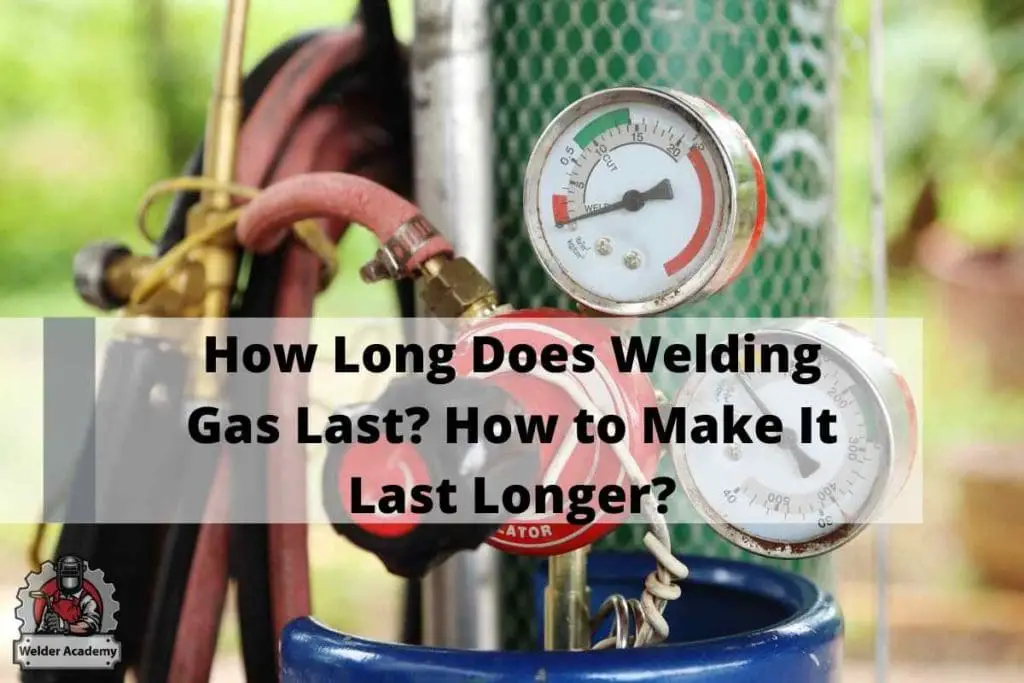The rise of MIG and TIG welding machines in the last few decades has been fascinating. Therefore, welding gas has grown substantially in usage as an essential component in many industries. Shielding the arc from air, dust and other eroding materials is the primary reason for using welding gas.
At a flow rate (CFH) of 25, a cylinder containing 125 cubic feet of gas (CF) typically lasts about 5 hours. We can calculate the duration of welding gas by dividing the cylinder capacity by the flow rate. However, numerous variables can influence how long the welding gas should last.

Welding gas, in addition to protecting the arc from impurities, also protects the underside of the seam and the heating metal. It also aids in the protection of metal after the completion of the welding process. In this article, I will go over the various gasses and mixtures that are currently in use in the welding industry.
What Are the Different Types of Welding Gasses?
There are five different types of gasses that welders commonly use in the welding process. The following gasses are used in the welding process: inert, shielding, purging, heating, and blanketing. Depending on the need and circumstances, all of these gasses are used in a variety of ways. A brief description of each of these types of gasses is provided below.
Inert and Reactive Gasses
Inert gasses are gasses that do not come into contact with any substances. Reactive gasses, on the other hand, tend to react vigorously with other substances.
Both of these gasses are advantageous for welding. Inert gasses help to speed up the natural welding process, whereas reactive gasses can cause a positive change in the welding process.
Shielding Gas
The formation of bubbles within the molten metal is a common occurrence when welding. As a result of these bubbles, it is common to produce a weak and unsightly weld. The purpose of shielding gas is to keep dust, debris, and air away from the molten metal.
Shielding gasses are mostly inert gasses, which means they do not participate in chemical reactions. Furthermore, the properties of inert gasses are ideal for the cause of shielding gasses because welding frequently produces extreme conditions. Shielding gasses aid in the creation of more fluidity and a softer surface on the bead.
Purging Gas
Purging gases serve a similar purpose to Shielding gasses but in a different way. Typically performed independently of the natural welding process, these gasses are most commonly found in stainless steel products. It is also worth noting that you can use a different type of gas than the one used at the top of the joint.
Heating Gas
In some cases, welders heat the metal rods to complete the welding process. Hence, in such cases, the need for an arc is rendered obsolete. Preheating with heating gasses is common. These gasses are mostly oxygen mixtures that aid in the ignition of a flame.
Blanketing Gas
Blanketing gasses are typically used in confined spaces such as tanks. They help protect a finished product from damage or staining after a welding process has been completed. To prevent reactions with other gasses, welders often mix blanketing gas with air. Pure argon, for example, works best with TIG projects, whereas a mixture of Argon and CO2 is more effective for MIG welding jobs.
Factors Affecting Welding Gas’s Duration
The welding gas’s shelf life depends on a number of factors. Here, I’ve discussed some of them.
Sizes and Flow Rates
To determine how long a specific welding gas will last, we can divide the capacity of the cylinder by the flow rate. The amount of gas released per hour is an important parameter in determining the duration of welding gas since it is a strong indicator of how long welding gasses should sustain.
Argon, for example, is a welding gas that comes in eight different sizes. The longer the gas should last, the larger the container’s capacity. The lower the cubic feet per hour, the longer that specific welding gas can be used. A typical welding project necessitates a flow rate of 10 Cubic Feet per Hour (CFH) to 35 CFH or higher.
You must consider the rate at which you will be served. Otherwise, there is a chance of losing valuable gas during the welding process. Another thing to consider is the density and velocity of the surrounding gasses. These factors frequently result in the formation of currents that can affect the flow of gas.
The key to achieving the optimal flow rate for welding gasses is to find the amount that reduces contamination while not risking breaking down the gas column. A laminar gas flow, for example, can increase flow stability and leave little room for contamination. However, if the flow rate becomes too low for atmospheric gasses, the weld may become contaminated.
Because welding professionals place more emphasis on flow rate, the pressure, which is measured in pounds per square inch (PSI), is frequently overlooked. Therefore, after determining the ideal CFH level, it is critical to adjust the PSI level accordingly.
Collet Body and Gas Lens
The Collet Body and Gas Lens are two of the most important pieces of welding gas flow control equipment. Collet Body is mostly used for standard applications, whereas Gas Lens is better suited for convoluted applications.
As gases exit the nozzle, the Collect Body can significantly increase the rate of flow. A gas lens, on the other hand, can reduce the speed of the gas flow to control turbulence.
Wire-Free Speed
Yes, the speed of the wire does matter in the welding process since it can determine the travel speed, as well as the size of the weld profile.
Due to the fact, enhanced speed necessitates a high level of CFH score to conduct proper coverage. However, the feed speed should be reasonable as faster than per speed can cause the wire to pile up and cause bird nesting.
How to Make Welding Gasses Last Longer?
The flow rate is the primary tool for determining how long a welding gas should last. Thereby, determining the appropriate flow rate that strikes the right balance between contamination and efficiency is critical. If the environment is not hostile, it is best to use CFH numbers on the low side.
A flowmeter can provide real-time data on the flow rate at any given time, which can be very useful for regulating CFH readings. It is advisable to use a flow gauge regulator to keep track of outdoor applications because it is a sustainable yet cost-effective option.
Why Your Welding Gas Might Not Be Lasting?
I imagine a lot of you are here because you suspect that your welding gas is not lasting enough. Or as much as they used to. And it could be a good thing to be concerned about. There are a few reasons why your welding gas might run out faster than it should.
First of all, leaks are an obvious cause. Keenly observe every nook and cranny of your welding gas cylinder and see if you can find any leaks. You can try checking the gauge and setting the cylinder aside for a while. Then check it again. If you see any noticeable change of pressure then your cylinder might be leaking.
Even if your cylinder is perfectly fine, the temperature can also cause leaks. During winter, the metals on the cylinder could shrink and cause leaks. So, be sure to keep them inside.
Conclusion
Gasses are the most important commodities in every welder’s life. It is critical to have a basic understanding of how long gasses can last in the welding process since it has many applications in our day-to-day life.
When it comes to welding gasses, there is a wide range to choose from. Thus, the selection of specific gasses should be based on their suitability for specific applications.
Understanding the intricacies of various gasses is critical to producing quality welds for their use. Thanks for sticking with me to the end of this article. Hopefully, you found the article to be an insightful read.
